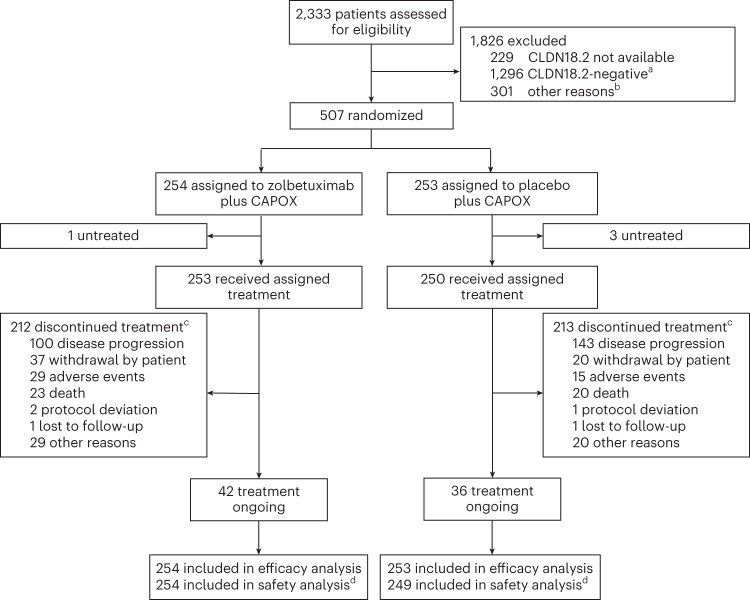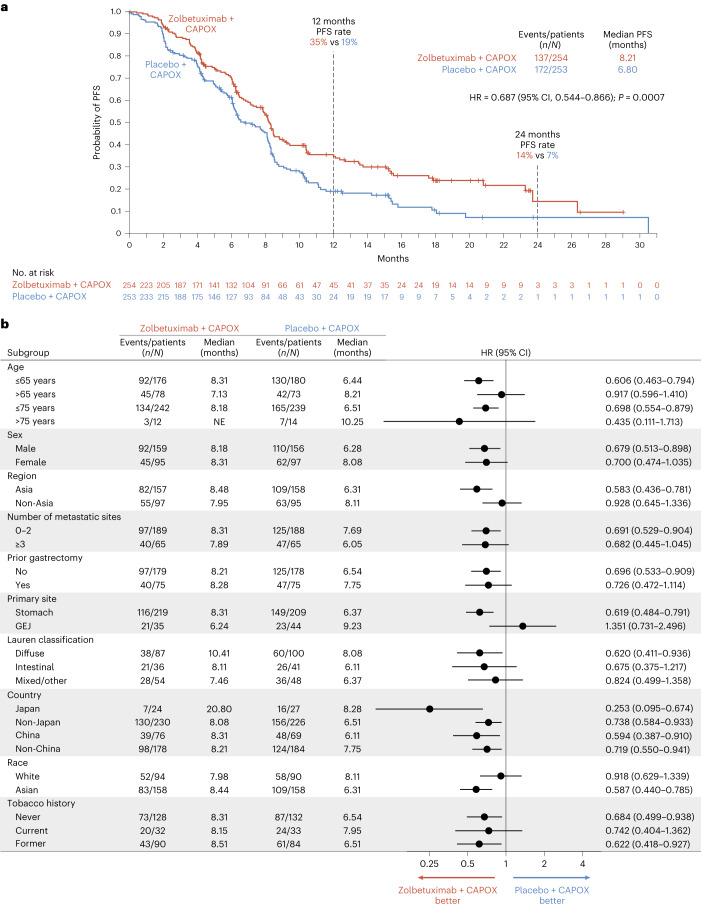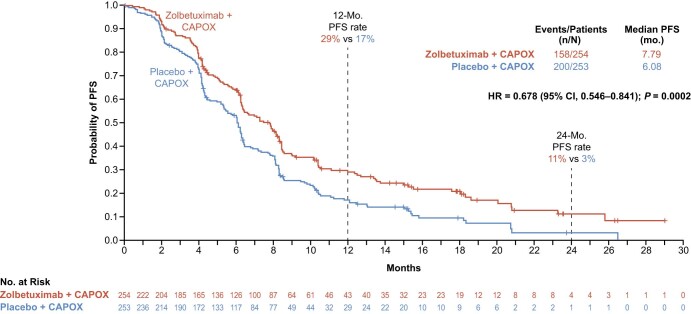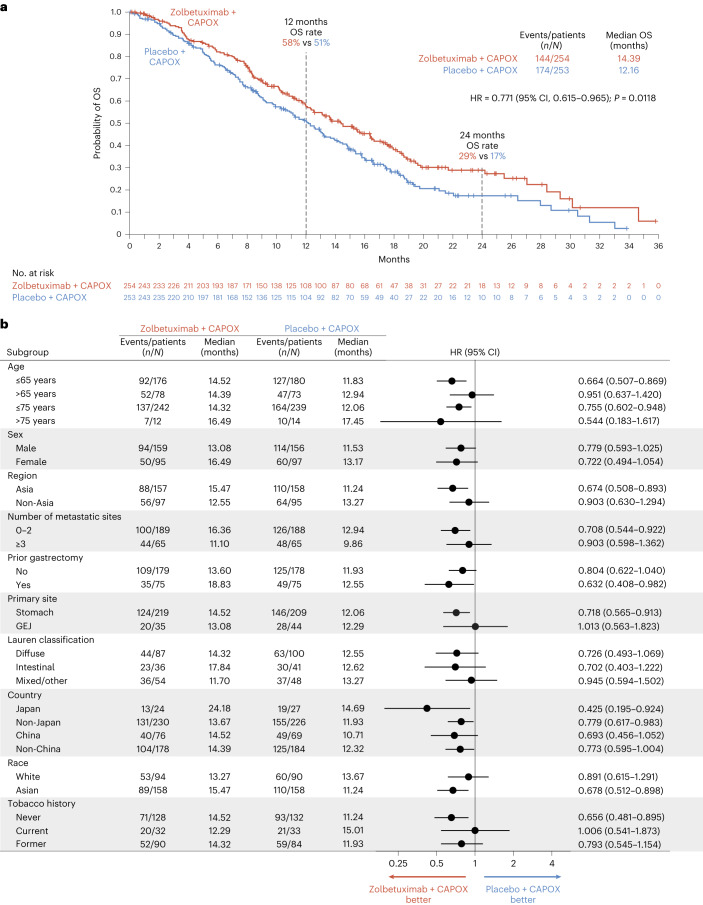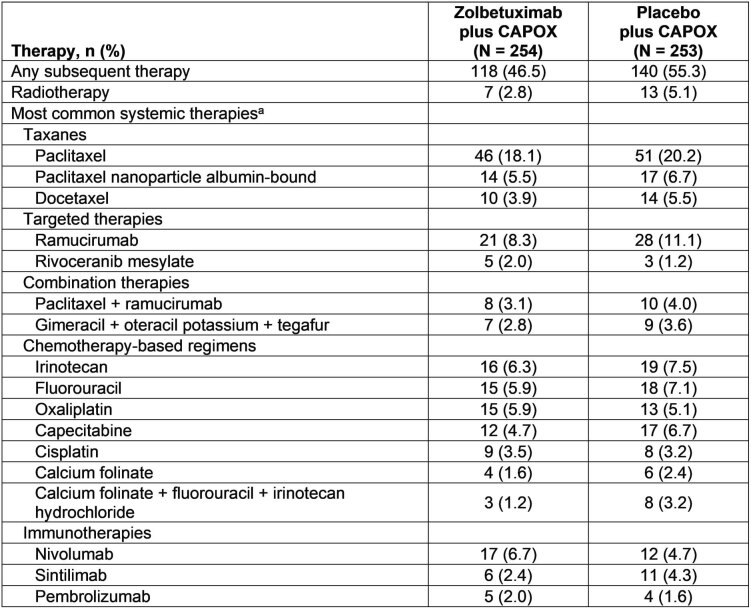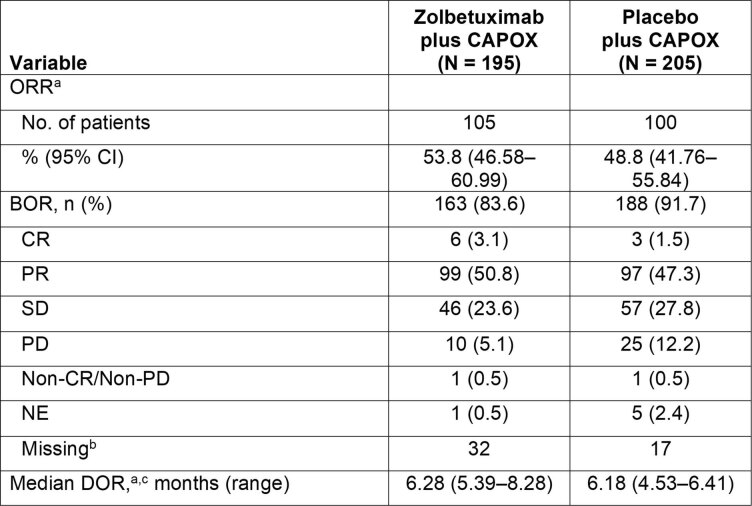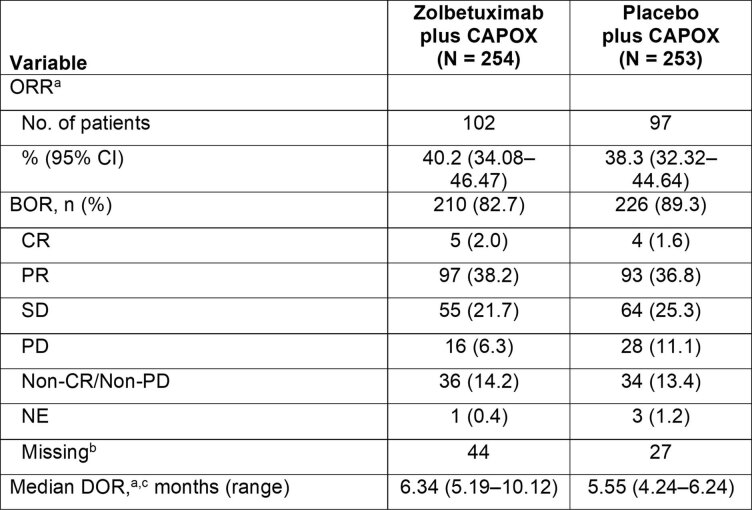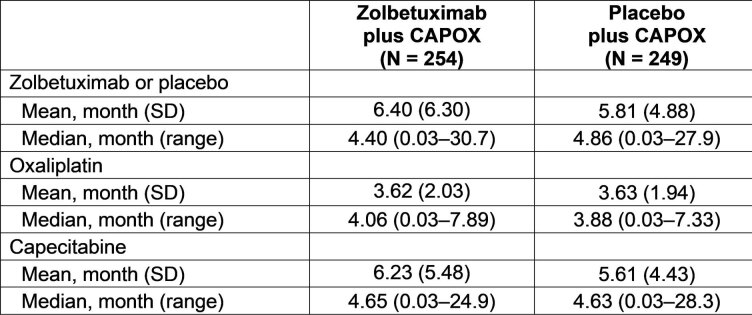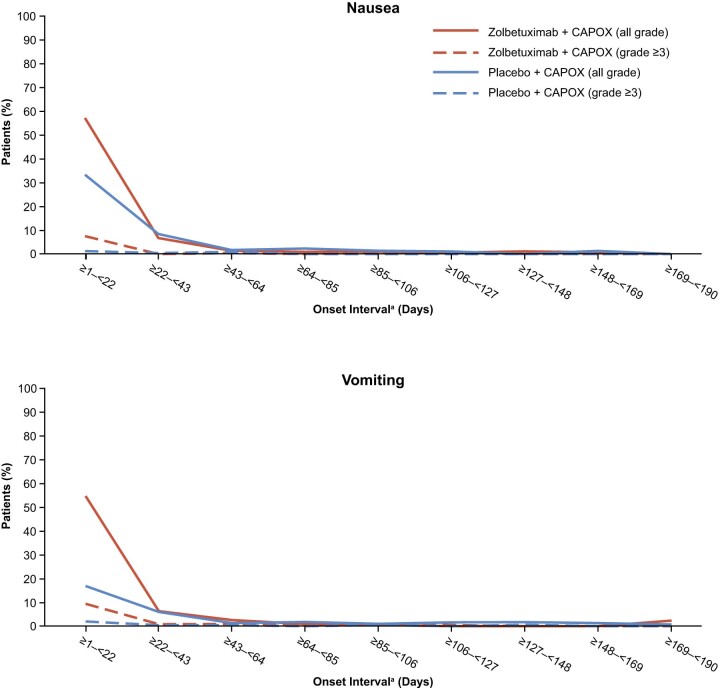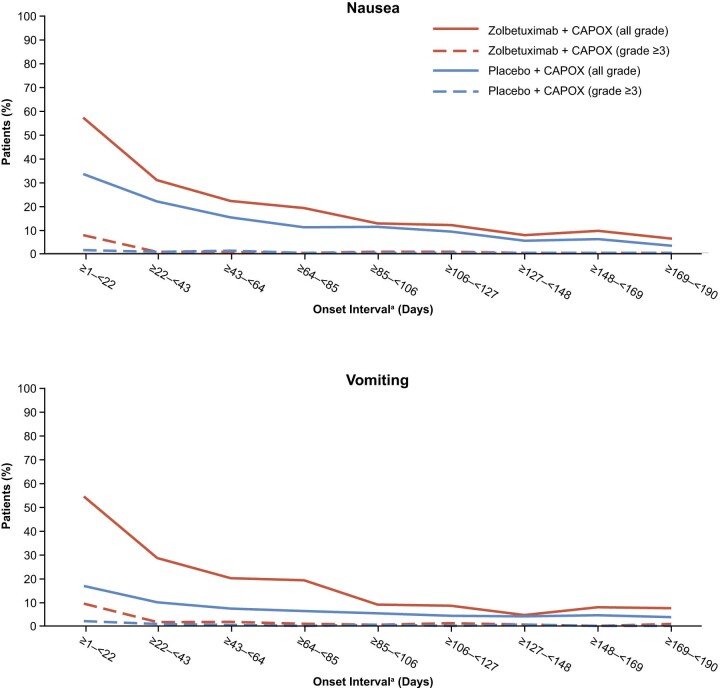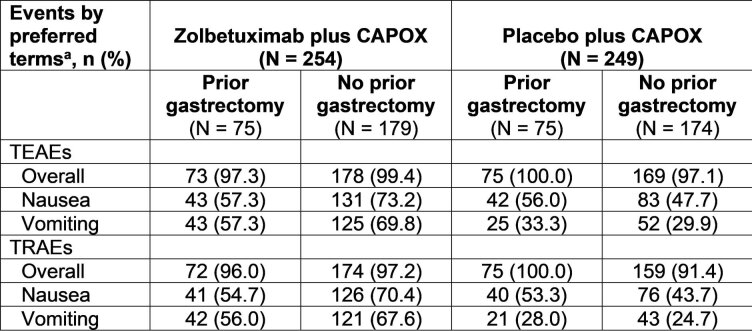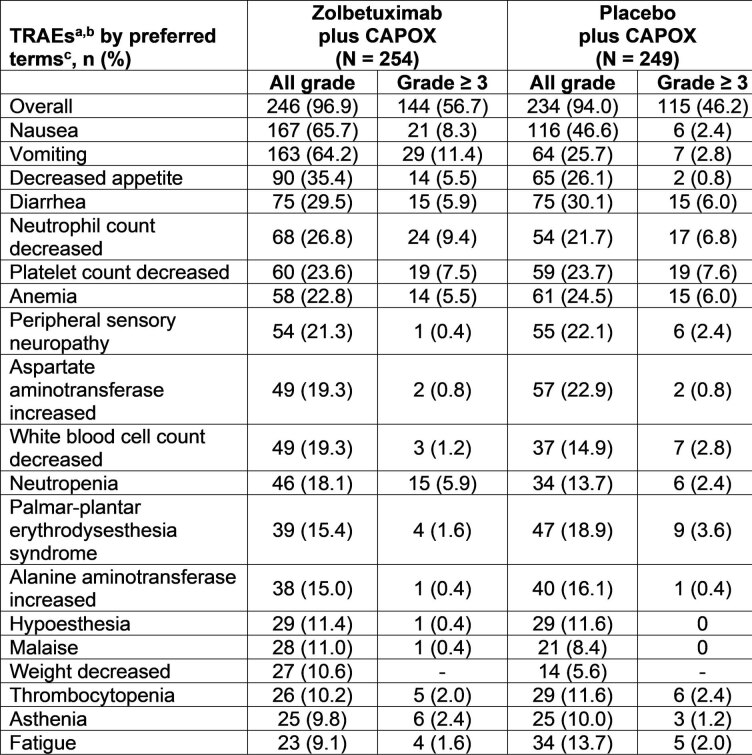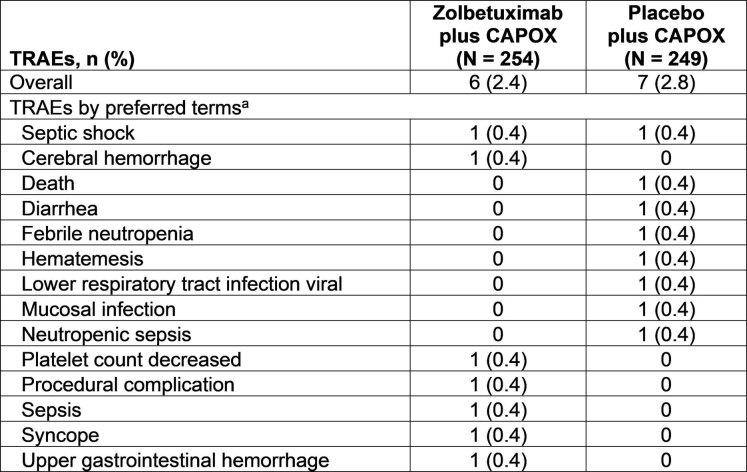Abstract
There is an urgent need for first-line treatment options for patients with human epidermal growth factor receptor 2 (HER2)-negative, locally advanced unresectable or metastatic gastric or gastroesophageal junction (mG/GEJ) adenocarcinoma. Claudin-18 isoform 2 (CLDN18.2) is expressed in normal gastric cells and maintained in malignant G/GEJ adenocarcinoma cells. GLOW (closed enrollment), a global, double-blind, phase 3 study, examined zolbetuximab, a monoclonal antibody that targets CLDN18.2, plus capecitabine and oxaliplatin (CAPOX) as first-line treatment for CLDN18.2-positive, HER2-negative, locally advanced unresectable or mG/GEJ adenocarcinoma. Patients (n = 507) were randomized 1:1 (block sizes of two) to zolbetuximab plus CAPOX or placebo plus CAPOX. GLOW met the primary endpoint of progression-free survival (median, 8.21 months versus 6.80 months with zolbetuximab versus placebo; hazard ratio (HR) = 0.687; 95% confidence interval (CI), 0.544–0.866; P = 0.0007) and key secondary endpoint of overall survival (median, 14.39 months versus 12.16 months; HR = 0.771; 95% CI, 0.615–0.965; P = 0.0118). Grade ≥3 treatment-emergent adverse events were similar with zolbetuximab (72.8%) and placebo (69.9%). Zolbetuximab plus CAPOX represents a potential new first-line therapy for patients with CLDN18.2-positive, HER2-negative, locally advanced unresectable or mG/GEJ adenocarcinoma. ClinicalTrials.gov identifier: NCT03653507.
Subject terms: Gastric cancer, Oesophageal cancer, Randomized controlled trials, Cancer therapy
In the randomized, double-blind, phase 3 GLOW trial, capecitabine and oxaliplatin combined with zolbetuximab, a monoclonal antibody that targets CLDN18.2, significantly improved progression-free survival and overall survival in patients with CLDN18.2-positive, HER2-negative, untreated, locally advanced unresectable or metastatic gastric or gastroesophageal junction adenocarcinoma.
Main
Gastric adenocarcinoma is the fifth most commonly diagnosed cancer worldwide, and incidence of gastroesophageal junction adenocarcinomas has markedly increased in the last few decades1–3. Because patients with early-stage disease are often asymptomatic, gastric or gastroesophageal junction (G/GEJ) adenocarcinomas are frequently diagnosed at an advanced or metastatic stage1. These cancers have some of the highest unmet medical needs1. Standard first-line therapy for patients with HER2-negative, locally advanced unresectable or metastatic G/GEJ (mG/GEJ) adenocarcinoma has been platinum-fluoropyrimidine chemotherapy; both folinic acid plus 5-fluorouracil and oxaliplatin (FOLFOX) and capecitabine plus oxaliplatin (CAPOX) are accepted standard chemotherapy regimens, although oral regimens are more convenient and preferred in Asia1,4–8. Patients receiving standard oxaliplatin-based doublet regimens survive approximately 1 year1,4,6–8.
The combination of targeted therapies or immunotherapies with chemotherapy can improve overall survival (OS) in some patients with metastatic disease8–11. Trastuzumab is approved for the approximately 15% of patients with HER2-positive disease3–6,9,12–15. Targeting programmed death-1 (PD-1) with nivolumab is approved as first-line therapy in more than 50 countries; efficacy has been mainly limited to patients with a programmed death-ligand 1 (PD-L1) combined positive score (CPS) ≥5, which occurs in approximately 20–60% of patients3–6,10,11,14,15. In some countries, targeting vascular endothelial growth factor receptor 2 with ramucirumab is approved alone or in combination with paclitaxel as second-line therapy1,3,4,6,16,17. An unmet need remains to develop additional targeted therapies to treat patients with HER2-negative, locally advanced unresectable or mG/GEJ adenocarcinoma1,3,18.
CLDN18.2 is a tight junction protein exclusively expressed in normal gastric mucosa cells and is retained in most G/GEJ adenocarcinomas14,19–24. In normal gastric mucosa, CLDN18.2 is typically buried within tight junctions19. During malignant transformation, loss of gastric mucosa cell polarity may result in CLDN18.2 becoming more exposed and, thus, accessible to therapeutic antibodies15,20–25.
Zolbetuximab is a first-in-class immunoglobulin G1 monoclonal antibody that targets CLDN18.2 and mediates antibody-dependent cellular cytotoxicity and complement-dependent cytotoxicity in CLDN18.2-positive G/GEJ adenocarcinoma cells20–22,26,27. The phase 2b FAST study demonstrated that the combination of zolbetuximab plus chemotherapy prolonged progression-free survival (PFS) and OS when compared with chemotherapy alone; the benefit was further enhanced in patients whose tumors had higher expression of CLDN18.2 (ref. 22). The recently reported primary results of SPOTLIGHT (NCT03504397)—a global, phase 3 study in patients with CLDN18.2-positive (≥75% of tumor cells with moderate-to-strong claudin-18 (CLDN18) membranous staining), HER2-negative disease—demonstrated that both PFS and OS were significantly prolonged in patients treated with first-line zolbetuximab plus a modified FOLFOX regimen (mFOLFOX6) compared with placebo plus mFOLFOX6 (ref. 28). The GLOW study (NCT03653507) was conducted simultaneously with SPOTLIGHT to confirm the efficacy of the addition of zolbetuximab to chemotherapy in the first-line treatment setting and to examine the addition of zolbetuximab with an alternative first-line chemotherapy backbone that has a different schedule and toxicity profile1,28,29. In addition, it was appropriate to assess the combination of zolbetuximab with mFOLFOX6 or CAPOX in patients from different geographic regions where one or the other chemotherapy regimen may be preferred3–6.
Here we report the primary analysis of GLOW, a global, randomized, double-blind, phase 3 study, which evaluated the efficacy and safety of first-line treatment with zolbetuximab plus CAPOX compared to placebo plus CAPOX in patients with CLDN18.2-positive, HER2-negative, locally advanced unresectable or mG/GEJ adenocarcinoma.
Results
Patients and treatment
Between 28 November 2018 and 18 February 2022, a total of 2,333 patients with previously untreated, locally advanced unresectable or mG/GEJ adenocarcinoma were screened at 166 sites in 18 countries. CLDN18.2 tumor status was assessed in 2,104 patients, of whom 808 (38.4%) had tumors that met the cutoff for CLDN18.2 positivity (≥75% of tumor cells with moderate-to-strong CLDN18 membranous staining as determined by central immunohistochemistry using the investigational VENTANA CLDN18 (43-14A) RxDx assay). Among patients whose tumors were assessed for CLDN18.2 status, 1,701 had tumors that were HER2-negative; 729 of 1,701 (42.9%) patients had tumors that met the cutoff for CLDN18.2 positivity. Of screened patients with tumors that were HER2-negative and met the cutoff for CLDN18.2 positivity, 222 were not randomized owing to failure to meet other inclusion criteria or the patient’s decision to withdraw from the study. Ultimately, 507 patients with CLDN18.2-positive tumors were randomly assigned to receive either zolbetuximab plus CAPOX (n = 254, hereafter ‘zolbetuximab’) or placebo plus CAPOX (n = 253, hereafter ‘placebo’) across 131 study sites (Fig. 1 and Supplementary Table 1). The recruitment period was from 21 January 2019 (first patient randomized) to 18 February 2022 (last patient randomized). At the data cutoff on 7 October 2022, the median trial follow-up was 12.62 months versus 12.09 months for PFS and 17.71 months versus 18.43 months for OS in patients randomized to receive zolbetuximab versus placebo, respectively. Demographic and baseline characteristics were generally well balanced between groups (Table 1 and Supplementary Table 2). As an ad hoc analysis, PD-L1 expression was evaluated using the Dako PD-L1 IHC 28-8 pharmDx assay in a subset of randomized patients for whom consented samples were available for testing; 225 of 288 (78.1%) patients were determined to have tumors with a PD-L1 CPS <5.
Fig. 1. CONSORT diagram of GLOW study.
a‘CLDN18.2-positive’ was defined as ≥75% of tumor cells with moderate-to-strong membranous CLDN18 staining as determined by central immunohistochemistry using the investigational VENTANA CLDN18 (43-14A) RxDx Assay. b‘Other’ represents patients whose tumors were CLDN18.2-positive but failed screening for other reasons, including laboratory findings, HER2 expression status, Eastern Cooperative Oncology Group (ECOG) performance status score, other exclusion criteria or withdrawal by patient. cIf patients discontinued from both zolbetuximab or placebo and CAPOX on the same day, all reasons for discontinuation were summarized; the sum of values for individual reasons for discontinuation is more than 212 for the zolbetuximab group and more than 213 for the placebo group. dOne patient randomized to the placebo plus CAPOX group received one dose of zolbetuximab as a protocol deviation and was moved to the zolbetuximab plus CAPOX group for the safety analysis set.
Table 1.
Demographics and clinical characteristics of the ITT population at baseline
| Characteristic | Overall (n = 507) | Zolbetuximab plus CAPOX (n = 254) | Placebo plus CAPOX (n = 253) |
|---|---|---|---|
| Median age (range), years | 60.0 (21–83) | 61.0 (22–82) | 59.0 (21–83) |
| Male sexa, n (%) | 315 (62.1) | 159 (62.6) | 156 (61.7) |
| Region, n (%) | |||
| Asia | 315 (62.1) | 157 (61.8) | 158 (62.5) |
| Non-Asia | 192 (37.9) | 97 (38.2) | 95 (37.5) |
| Organs with metastases, n (%) | |||
| 0–2 | 377 (74.4) | 189 (74.4) | 188 (74.3) |
| ≥3 | 130 (25.6) | 65 (25.6) | 65 (25.7) |
| Prior gastrectomy, n (%) | |||
| Yes | 150 (29.6) | 75 (29.5) | 75 (29.6) |
| No | 357 (70.4) | 179 (70.5) | 178 (70.4) |
| Primary site, n (%) | |||
| Stomach | 428 (84.4) | 219 (86.2) | 209 (82.6) |
| GEJ | 79 (15.6) | 35 (13.8) | 44 (17.4) |
| Lauren classification, n (%) | |||
| Diffuse | 187 (37.0) | 87 (34.4) | 100 (39.5) |
| Intestinal | 77 (15.2) | 36 (14.2) | 41 (16.2) |
| Mixed | 41 (8.1) | 20 (7.9) | 21 (8.3) |
| Unknownb | 140 (27.7) | 76 (30.0) | 64 (25.3) |
| Other | 61 (12.1) | 34 (13.4) | 27 (10.7) |
| Missing | 1 | 1 | 0 |
| ECOG performance status score, n (%) | |||
| 0 | 216 (42.9) | 108 (42.7) | 108 (43.2) |
| 1 | 287 (57.1) | 145 (57.3) | 142 (56.8) |
| Missingc | 4 | 1 | 3 |
| Measurable diseased, n (%) | |||
| Yes | 400 (78.9) | 195 (76.8) | 205 (81.0) |
| No | 107 (21.1) | 59 (23.2) | 48 (19.0) |
aSex was reported by study site staff through an interactive response technology system with options ‘male’ or ‘female’.
bPatients with Lauren classification ‘unknown’ had adenocarcinoma without Lauren classification.
cBaseline measurements were reported at cycle 1, day 1. Patients reported as ‘Missing’ did not receive any treatment; thus, no baseline was defined per the Statistical Analysis Plan. However, at screening, these patients had an Eastern Cooperative Oncology Group (ECOG) performance status score of 0 or 1 and were, thus, eligible for enrollment.
dBased on central assessment.
The primary endpoint was PFS per Response Evaluation Criteria in Solid Tumors (RECIST) version 1.1 as determined by an independent review committee (IRC). A key secondary endpoint was OS; additional secondary endpoints were objective response rate (ORR) and duration of response (DOR) per RECIST version 1.1 as determined by an IRC and safety and tolerability of zolbetuximab. Time to confirmed deterioration in scores for European Organization for Research and Treatment of Cancer global health status and quality of life, physical functioning and abdominal pain and discomfort assessments as a key secondary endpoint was not reported in this manuscript owing to the pending clinically meaningful threshold from the ongoing exit survey study per protocol. Additional secondary endpoints not reported in this manuscript were additional patient-reported outcomes and pharmacokinetics and immunogenicity of zolbetuximab. Efficacy endpoints were assessed in the intent-to-treat (ITT) population, which included all randomized patients. Safety was assessed in the safety analysis set, which included all patients who received at least one dose of any study drug.
PFS
PFS as the primary endpoint was statistically significantly prolonged in patients randomized to receive zolbetuximab versus placebo (median, 8.21 months versus 6.80 months, respectively; hazard ratio (HR) = 0.687; 95% confidence interval (CI), 0.544–0.866; P = 0.0007) (Fig. 2a). The estimated 12-month PFS rates were 35% in the zolbetuximab arm versus 19% in the placebo arm, and the 24-month PFS rates were 14% versus 7%, respectively, consistently favoring zolbetuximab. PFS was consistently longer in patients in the zolbetuximab arm versus the placebo arm across most of the pre-specified subgroups (Fig. 2b). As a sensitivity analysis, PFS per investigator assessment was also statistically significantly prolonged in patients in the zolbetuximab arm versus the placebo arm (median, 7.79 months versus 6.08 months, respectively; HR = 0.678; 95% CI, 0.546–0.841; P = 0.0002) (Extended Data Fig. 1).
Fig. 2. PFS in the ITT population.
a, Kaplan–Meier PFS curves of all patients. b, Forest plots of PFS by subgroups.
Extended Data Fig. 1. PFS in the ITT population by investigator.
Kaplan-Meier curve of PFS in all patients. CAPOX, capecitabine plus oxaliplatin regimen; CI, confidence interval; HR, hazard ratio; ITT, intent-to-treat; mo., months; No., number; PFS, progression-free survival.
OS
At the interim analysis, 318 out of 507 (62.7%) patients had died: 144 of the 254 (56.7%) patients randomized to receive zolbetuximab, and 174 of the 253 (68.8%) patients randomized to receive placebo. OS as a key secondary endpoint was statistically significantly prolonged in patients in the zolbetuximab arm versus the placebo arm (median, 14.39 months versus 12.16 months, respectively; HR = 0.771; 95% CI, 0.615–0.965; P = 0.0118) (Fig. 3a). The estimated 12-month OS rates were 58% in the zolbetuximab arm versus 51% in the placebo arm, and the 24-month OS rates were 29% versus 17%, respectively. OS was consistently longer in patients in the zolbetuximab arm versus the placebo arm across most of the pre-specified subgroups (Fig. 3b).
Fig. 3. OS in the ITT population.
a, Kaplan–Meier OS curves of all patients. b, Forest plots of OS by subgroups.
Subsequent anti-cancer therapies were administered to 118 of 254 (46.5%) patients in the zolbetuximab arm versus 140 of 253 (55.3%) patients in the placebo arm (Extended Data Table 1). The types of therapies were well balanced between the zolbetuximab and placebo arms.
Extended Data Table 1.
Subsequent anti-cancer therapies in the ITT population
a Systemic therapies administered to ≥2% of patients in either treatment arm are reported.
Radiographic response
In the ITT population, as assessed by an IRC as secondary endpoints, ORR was 42.5% (108 of 254 patients; 95% CI, 36.36–48.85) in the zolbetuximab arm versus 40.3% (102 of 253 patients; 95% CI, 34.22–46.64) in the placebo arm, and DOR was 6.14 months (95% CI, 5.03–8.08) versus 6.08 months (95% CI, 4.44–6.34), respectively (Table 2). As an ad hoc analysis, in patients with measurable lesions, as assessed by an IRC, the ORR was 53.8% (105 of 195 patients; 95% CI, 46.58–60.99) in the zolbetuximab arm versus 48.8% (100 of 205 patients; 95% CI, 41.76–55.84) in the placebo arm; a complete response was observed in 3.1% versus 1.5% of patients, and a partial response was observed in 50.8% versus 47.3% of patients, respectively (Extended Data Table 2). In patients with measurable lesions, the median DOR was 6.28 months (95% CI, 5.39–8.28) in the zolbetuximab arm versus 6.18 months (95% CI, 4.53–6.41) in the placebo arm (Extended Data Table 2). As a sensitivity analysis, in the ITT population, as assessed by investigators, the ORR was 40.2% (102 of 254 patients; 95% CI, 34.08–46.47) in the zolbetuximab arm versus 38.3% (97 of 253 patients; 95% CI, 32.32–44.64) in the placebo arm; the median DOR was 6.34 months (95% CI, 5.19–10.12) versus 5.55 months (95% CI, 4.24–6.24), respectively (Extended Data Table 3).
Table 2.
Anti-tumor activity in the ITT population
| Variable | Zolbetuximab plus CAPOX (n = 254) | Placebo plus CAPOX (n = 253) |
|---|---|---|
| ORRa | ||
| No. of patients | 108 | 102 |
| % (95% CI) | 42.5 (36.36–48.85) | 40.3 (34.22–46.64) |
| BOR, n (%) | 210 (82.7) | 226 (89.3) |
| CR | 9 (3.5) | 5 (2.0) |
| PR | 99 (39.0) | 97 (38.3) |
| SD | 46 (18.1) | 57 (22.5) |
| PD | 11 (4.3) | 28 (11.1) |
| Non-CR/Non-PD | 40 (15.7) | 33 (13.0) |
| NE | 1 (0.4) | 5 (2.0) |
| ND | 4 (1.6) | 1 (0.4) |
| Missingb | 44 | 27 |
| Median DORa,c, months (range) | 6.14 (5.03–8.08) | 6.08 (4.44–6.34) |
aPer RECIST version 1.1 by IRC.
bPatients with missing data had no post-baseline imaging assessment.
cDOR is reported among patients with an objective response.
BOR, best overall response; CR, complete response; ND, no disease; NE, not evaluable; PD, progressive disease; PR, partial response; SD, stable disease.
Extended Data Table 2.
Anti-tumor activity in patients with measurable lesions
a Per RECIST version 1.1 by IRC.
b Patients with missing data had no post-baseline imaging assessment.
c DOR is reported among patients with an objective response.
BOR, best overall response; CR, complete response; ND, no disease; NE, not evaluable; No., number; PD, progressive disease; PR, partial response; SD, stable disease.
Extended Data Table 3.
Anti-tumor activity in the ITT population assessed by investigator
a Per RECIST version 1.1.
b Patients with missing data had no post-baseline imaging assessment.
c DOR is reported among patients with an objective response.
BOR, best overall response; CR, complete response; ND, no disease; NE, not evaluable; No., number; PD, progressive disease; PR, partial response; SD, stable disease.
Safety
Safety was assessed as a secondary endpoint, and the severity of adverse events was graded according to the National Cancer Institute Common Terminology Criteria for Adverse Events version 4.03. The mean duration of exposure to zolbetuximab was 6.40 months (s.d., 6.30) and to placebo was 5.81 months (s.d., 4.88); the mean duration of exposure to CAPOX was similar between the zolbetuximab and placebo arms (Extended Data Table 4). The median duration of exposure to zolbetuximab or placebo, and CAPOX, was also similar between the zolbetuximab and placebo arms (Extended Data Table 4). Treatment-emergent adverse events (TEAEs) of grade ≥3 occurred in 185 of 254 (72.8%) patients in the zolbetuximab arm versus 174 of 249 (69.9%) patients in the placebo arm (Table 3); the most common grade ≥3 TEAEs, based on TEAEs in the zolbetuximab arm, were vomiting (12.2% versus 3.6% of patients, respectively), anemia (10.6% versus 11.2%), neutrophil count decreased (10.2% versus 9.6%) and nausea (8.7% versus 2.4%).
Extended Data Table 4.
Duration of exposure of each treatment component in the safety analysis set
The duration of each component is defined as date of last dose minus date of first dose plus 1.
Table 3.
Adverse events in the safety analysis set
| Events, n (%) | Zolbetuximab plus CAPOX (n = 254) | Placebo plus CAPOX (n = 249) | ||
|---|---|---|---|---|
| All-grade TEAEs | 251 (98.8) | 244 (98.0) | ||
| Grade ≥3 TEAEs | 185 (72.8) | 174 (69.9) | ||
| Serious TEAEs | 120 (47.2) | 124 (49.8) | ||
| TEAEs leading to discontinuation of any study drug | 79 (31.1) | 63 (25.3) | ||
| TRAEs leading to discontinuation of any study drug | 55 (21.7) | 39 (15.7) | ||
| TEAEs leading to discontinuation of zolbetuximab or placebo | 51 (20.1) | 36 (14.5) | ||
| TRAEs leading to discontinuation of zolbetuximab or placebo | 18 (7.1) | 11 (4.4) | ||
| TEAEs leading to death | 27 (10.6) | 32 (12.9) | ||
| TRAEs leading to death | 6 (2.4) | 7 (2.8) | ||
| TEAEsa by preferred termsb | All grade | Grade ≥3 | All grade | Grade ≥3 |
| Nausea | 174 (68.5) | 22 (8.7) | 125 (50.2) | 6 (2.4) |
| Vomiting | 168 (66.1) | 31 (12.2) | 77 (30.9) | 9 (3.6) |
| Decreased appetite | 105 (41.3) | 17 (6.7) | 84 (33.7) | 4 (1.6) |
| Anemia | 90 (35.4) | 27 (10.6) | 91 (36.5) | 28 (11.2) |
| Diarrhea | 80 (31.5) | 15 (5.9) | 86 (34.5) | 18 (7.2) |
| Neutrophil count decreased | 70 (27.6) | 26 (10.2) | 59 (23.7) | 24 (9.6) |
| Aspartate aminotransferase increased | 63 (24.8) | 6 (2.4) | 72 (28.9) | 7 (2.8) |
| Platelet count decreased | 61 (24.0) | 19 (7.5) | 60 (24.1) | 20 (8.0) |
| Hypoalbuminemia | 57 (22.4) | 8 (3.1) | 35 (14.1) | 4 (1.6) |
| Peripheral sensory neuropathy | 56 (22.0) | 1 (0.4) | 56 (22.5) | 6 (2.4) |
| White blood cell count decreased | 51 (20.1) | 5 (2.0) | 39 (15.7) | 9 (3.6) |
| Neutropenia | 50 (19.7) | 18 (7.1) | 35 (14.1) | 7 (2.8) |
| Weight decreased | 50 (19.7) | 1 (0.4) | 25 (10.0) | 1 (0.4) |
| Alanine aminotransferase increased | 48 (18.9) | 2 (0.8) | 52 (20.9) | 7 (2.8) |
| Palmar-plantar erythrodysesthesia syndrome | 41 (16.1) | 4 (1.6) | 49 (19.7) | 9 (3.6) |
| Abdominal pain | 40 (15.7) | 1 (0.4) | 54 (21.7) | 4 (1.6) |
| Constipation | 39 (15.4) | − | 52 (20.9) | − |
| Hypokalemia | 36 (14.2) | 14 (5.5) | 36 (14.5) | 16 (6.4) |
| Fatigue | 34 (13.4) | 7 (2.8) | 42 (16.9) | 9 (3.6) |
| Pyrexia | 34 (13.4) | 1 (0.4) | 23 (9.2) | 0 |
| Asthenia | 33 (13.0) | 7 (2.8) | 32 (12.9) | 3 (1.2) |
| Malaise | 31 (12.2) | 1 (0.4) | 22 (8.8) | 0 |
| Hypoesthesia | 30 (11.8) | 1 (0.4) | 30 (12.0) | 0 |
| Thrombocytopenia | 28 (11.0) | 7 (2.8) | 31 (12.4) | 7 (2.8) |
| Insomnia | 27 (10.6) | − | 16 (6.4) | − |
| Edema peripheral | 26 (10.2) | 1 (0.4) | 6 (2.4) | 0 |
aThe all-grade TEAEs reported here occurred in ≥10% of patients in either treatment arm.
bPreferred terms were defined according to the Medical Dictionary for Regulatory Activities terminology version 25.0.
Nausea and vomiting were the only all-grade TEAEs with a more than 10% difference in incidence between patients receiving zolbetuximab versus placebo (nausea, 68.5% versus 50.2%, respectively; vomiting, 66.1% versus 30.9%; Table 3). The incidences of nausea and vomiting were most common during the first treatment cycle and decreased in subsequent cycles (Extended Data Figs. 2 and 3 and Supplementary Tables 3–6). In patients with prior gastrectomy, as either TEAEs or treatment-related adverse events (TRAEs), there was a more than 10% difference in the incidence of vomiting but not nausea in the zolbetuximab compared with the placebo arm, whereas, in patients without prior gastrectomy, there was a more than 10% difference in the incidence of both nausea and vomiting in the zolbetuximab arm compared with the placebo arm (Extended Data Table 5). In patients receiving zolbetuximab but not in patients receiving placebo, nausea and vomiting as TEAEs or as TRAEs were more frequent in patients without prior gastrectomy (Extended Data Table 5).
Extended Data Fig. 2. First occurrence of nausea and vomiting in the safety analysis set.
Events were counted if they did not occur in any previous onset interval. Individual data points are reported in Supplementary Tables 3 and 4. aThe onset day in the onset interval was defined as the date of onset minus the date of first dose plus 1. CAPOX, capecitabine plus oxaliplatin regimen.
Extended Data Fig. 3. All occurrence of nausea and vomiting in the safety analysis set.
Individual data points are reported in Supplementary Tables 5 and 6. aThe onset day in the onset interval was defined as the date of onset minus the date of first dose plus 1. CAPOX, capecitabine plus oxaliplatin regimen.
Extended Data Table 5.
Incidence of nausea and vomiting in patients with or without prior gastrectomy
a Preferred terms were defined according to the Medical Dictionary for Regulatory Activities terminology
version 25.0.
TRAEs led to discontinuation of zolbetuximab in 18 of 254 (7.1%) patients versus discontinuation of placebo in 11 of 249 (4.4%) patients (Table 3); individual events are reported in Extended Data Table 6. Grade 5 TRAEs occurred in six (2.4%) patients receiving zolbetuximab versus seven (2.8%) patients receiving placebo (Table 3); individual events are reported in Extended Data Table 7.
Extended Data Table 6.
TRAEs in the safety analysis set
a The all-grade TRAEs reported here occurred in ≥10% of patients in either treatment arm.
b Adverse events with a reasonable possibility of relationship as assessed by the investigator or missing relationship are reported here.
c Preferred terms were defined according to the Medical Dictionary for Regulatory Activities terminology version 25.0.
Extended Data Table 7.
Grade 5 TRAEs leading to death in the safety analysis set
a Preferred terms were defined according to the Medical Dictionary for Regulatory Activities terminology version 25.0.
Discussion
In GLOW, the addition of first-line zolbetuximab to CAPOX significantly improved PFS and OS in patients with CLDN18.2-positive, HER2-negative, locally advanced unresectable or mG/GEJ adenocarcinoma. GLOW confirmed the increased survival benefit of adding zolbetuximab to chemotherapy observed in previous phase 2 and 3 studies22,28. GLOW and SPOTLIGHT showed a similar reduction in the risk of disease progression or death (~31% and ~25%, respectively) and a similar reduction in the risk of death (~25% in both studies) with the addition of zolbetuximab to chemotherapy when compared with placebo plus chemotherapy28. As both PFS and OS are time-to-event endpoints, the interpretation of efficacy was based on the HR; the consistent HRs observed in both GLOW and SPOTLIGHT represent a clinically meaningful benefit. The survival benefit for both PFS and OS with zolbetuximab plus CAPOX compared with placebo plus CAPOX was consistently maintained across most of the pre-specified subgroups in GLOW, consistent with SPOTLIGHT28. Patients still on trial will continue to be followed-up to collect survival data.
Although the control arm in SPOTLIGHT performed better than expected, in GLOW, the control arm performed as expected, which is in line with other studies that suggest that CLDN18.2 is not a prognostic biomarker14,28,30. Notably, SPOTLIGHT enrolled more patients from Japan and South Korea, whereas GLOW enrolled more patients from mainland China, whose disease course tends to be more similar to that of patients from Western countries, with a lower OS than patients from Japan28,31. In the ATTRACTION-4 study, which enrolled patients from Japan, South Korea and Taiwan, the control arm demonstrated a longer median OS compared with other global studies10,32. Although delay in the separation of the survival curves in GLOW occurred to a lesser degree than in SPOTLIGHT, in both studies, possible explanations for this observation include (1) the mechanism of action of zolbetuximab in inducing the innate immune system through antibody-dependent cellular cytotoxicity or (2) early discontinuation of patients in the zolbetuximab arm due to nausea and vomiting28. Taken together, the consistent survival benefits in both GLOW and SPOTLIGHT validate CLDN18.2 as a new target and demonstrate that zolbetuximab prolongs PFS and OS when combined with chemotherapy in patients with CLDN18.2-positive, HER2-negative, locally advanced unresectable or mG/GEJ adenocarcinoma28. The clinical responses in the ITT population as evaluated by an IRC were similar between treatment arms in GLOW. Similarly, in SPOTLIGHT, the ORR and DOR were similar in patients treated with zolbetuximab plus mFOLFOX6 compared to placebo plus mFOLFOX6 (ref. 28). In GLOW, in patients with measurable lesions, there was a 5% benefit in ORR for patients treated with zolbetuximab plus chemotherapy compared to placebo plus chemotherapy (53.8% versus 48.8%, respectively). The phase 2 FAST study showed a 14% benefit in ORR for patients treated with zolbetuximab plus chemotherapy compared with chemotherapy alone (39% versus 25%, respectively)22. In the phase 2 MONO study, zolbetuximab monotherapy demonstrated a 14% ORR in patients whose tumors had high CLDN18.2 expression23. The study designs of GLOW and SPOTLIGHT were different from those of FAST and MONO, and, therefore, comparisons across studies should be made with caution22,23,28. However, it is possible that zolbetuximab may prolong the duration of disease stabilization when combined with chemotherapy, leading to increased PFS and OS benefits, as opposed to tumor shrinkage; the reason that zolbetuximab did not improve response rates in GLOW and SPOTLIGHT is unclear at this time. Although the response rates between treatment arms were similar in GLOW, the PFS and OS benefits observed in GLOW were clinically meaningful and statistically significant; it is not uncommon for response rates to not correlate with clinical benefits in PFS and OS33.
GLOW demonstrated that CLDN18.2 is a prevalent biomarker in HER2-negative, locally advanced unresectable or mG/GEJ adenocarcinoma. In GLOW, 38.4% of screened patients with tumors assessable for CLDN18.2 expression had tumors that met the cutoff for CLDN18.2 positivity. In SPOTLIGHT, 38.4% of screened patients with tumors assessable for CLDN18.2 expression also had CLDN18.2-positive tumors28. Notably, the same prevalence rate was observed in both GLOW and SPOTLIGHT despite differences in the representation of countries in these two studies28. Previous retrospective studies have suggested that there is no significant correlation between CLDN18.2 positivity and expression of biomarkers such as HER2 and PD-L1; these data suggest similar prevalence of HER2 and PD-L1 in CLDN18.2-positive and CLDN18.2-negative G/GEJ adenocarcinoma14,30. In GLOW and SPOTLIGHT, the overlap of CLDN18.2 and PD-L1 tumor expression was evaluated as an ad hoc analysis in a subset of randomized patients; in GLOW, 21.9% of assessed patients had tumors with a PD-L1 CPS ≥5, and, in SPOTLIGHT, 13.2% of assessed patients had tumors with a PD-L1 CPS ≥5 (ref. 28). Together, these studies establish CLDN18.2 as a prevalent and unique biomarker that defines a population of patients with CLDN18.2-positive tumors who benefit from targeted therapy with zolbetuximab in combination with chemotherapy. Specifically, targeting of CLDN18.2 with zolbetuximab may fulfill an unmet need among a subset of HER2-negative patients.
In GLOW, the most common TEAEs observed in patients who received zolbetuximab plus CAPOX were nausea and vomiting; these events occurred at a more than 10% difference compared with patients who received placebo plus CAPOX. These results are consistent with the safety profile of zolbetuximab monotherapy and zolbetuximab plus chemotherapy observed in previous phase 1, 2 and 3 studies21–23,28. Nausea and vomiting were mostly observed during the first cycle of zolbetuximab treatment, similar to SPOTLIGHT, and the incidences of grade ≥3 events were reduced to less than 2% in later cycles; nausea and vomiting were managed by antiemetics, dose interruptions and infusion rate adjustments28. The rate of significant (grade ≥3) nausea and vomiting was lower in GLOW than in SPOTLIGHT in both arms, possibly due to the alignment of the chemotherapy and zolbetuximab administration schedules in GLOW28. The effect of nausea and vomiting on patient quality of life will be formally evaluated when the results of time to confirmed deterioration and other patient-reported outcomes data are mature. The manageable safety profile and significant survival benefit indicate a favorable benefit–risk profile for zolbetuximab plus chemotherapy.
This study had some limitations. First, this study was underpowered to statistically determine the effectiveness of zolbetuximab plus CAPOX in the pre-specified subgroups. In all cases, these subgroups were relatively small, and so interpretations should be made with caution. Next, this study did not evaluate the combination of zolbetuximab with nivolumab. Chemotherapy was selected as a relevant comparator arm in GLOW because nivolumab was not approved in this patient population at the time of study initiation. Furthermore, there is a substantial number of patients in this population whose disease does not respond to nivolumab. The ILUSTRO study (NCT03505320) is currently evaluating the efficacy and safety of targeting CLDN18.2 with zolbetuximab plus targeting PD-1 with nivolumab in combination with chemotherapy as first-line treatment for patients with CLDN18.2-positive, HER2-negative, locally advanced unresectable or mG/GEJ adenocarcinoma.
Overall, treatment with zolbetuximab plus CAPOX led to statistically significantly prolonged PFS and OS compared to placebo plus CAPOX in patients with CLDN18.2-positive, HER2-negative, locally advanced unresectable or mG/GEJ adenocarcinoma. These results further confirm the survival benefits observed in the phase 3 SPOTLIGHT study28. Together, these studies support the consideration of biomarker testing for tumor expression of CLDN18.2 and the use of zolbetuximab as a first-line therapy in combination with chemotherapy as a new potential standard of care in this biomarker-selected patient population.
Methods
Trial oversight
Astellas (the study sponsor) collaborated with the academic authors on the design of the study and on the collection and interpretation of the data after analysis. The protocol and all amendments were approved by the appropriate independent ethics committee (IEC) or institutional review board (IRB) at each participating institution (Supplementary Table 1). Patients provided written informed consent before participating in the trial. All authors attest that the trial was conducted in accordance with the Declaration of Helsinki and the standards of Good Clinical Practice. At pre-specified intervals during study conduct, an independent data monitoring committee reviewed unblinded efficacy and safety data. All authors had access to the study data, were involved in the writing or review and editing of the manuscript and vouch for the fidelity of the trial to the protocol and the completeness and accuracy of the data reported. The manuscript was written by the authors with assistance from a medical writer employed by the sponsor. The trial was registered at ClinicalTrials.gov (NCT03653507).
Patients
Eligible patients were adults according to local regulations and had CLDN18.2-positive (defined as ≥75% of tumor cells with moderate-to-strong membranous CLDN18 staining as determined by central immunohistochemistry using the investigational VENTANA CLDN18 (43-14A) RxDx Assay), HER2-negative (per local or central testing), previously untreated, locally advanced unresectable or mG/GEJ tumors with radiologically evaluable disease according to RECIST version 1.1. Patients had an ECOG performance status score of 0 or 1 and adequate organ function. Full inclusion and exclusion criteria are as follows:
Inclusion criteria
General criteria:
IRB/IEC-approved written informed consent and privacy language as per national regulations (for example, Health Insurance Portability and Accountability Act (HIPAA) authorization for US sites) must be obtained from the patient or legally authorized representative (if applicable) before any study-related procedures.
Patient is considered an adult (for example, ≥18 years of age in the USA) according to local regulation at the time of signing the informed consent.
A female patient is eligible to participate if she is not pregnant (negative serum pregnancy test at screening; female patients with elevated serum beta human chorionic gonadotropin (βhCG) and a demonstrated non-pregnant status through additional testing are eligible) and at least one of the following conditions applies.
Not a woman of childbearing potential (WOCBP) as defined in Protocol Appendix 12.3 Contraception Requirements
OR
WOCBP who agrees to follow the contraceptive guidance as defined in Protocol Appendix 12.3 Contraception Requirements throughout the treatment period and for 9 months after the final administration of oxaliplatin and 6 months after the final administration of all other study drugs
-
4.
Female patient must agree not to breastfeed starting at screening and throughout the study period and for 6 months after the final study treatment administration.
-
5.
Female patient must not donate ova starting at screening and throughout the study period and for 9 months after the final administration of oxaliplatin and for 6 months after the final administration of all other study drugs.
-
6.
Male patient with female partner(s) of childbearing potential must agree to use contraception as detailed in Protocol Appendix 12.3 Contraception Requirements during the treatment period and for 6 months after the final study treatment administration.
-
7.
Male patient must not donate sperm during the treatment period and for 6 months after the final study treatment administration.
-
8.
Male patient with a pregnant or breastfeeding partner(s) must agree to remain abstinent or use a condom for the duration of the pregnancy or time partner is breastfeeding throughout the study period and for 6 months after the final study treatment administration.
-
9.
Patient agrees not to participate in another interventional study while receiving study drug in the present study.
Disease-specific criteria:
-
10.
Patient has histologically confirmed diagnosis of G/GEJ adenocarcinoma.
-
11.
Patient has radiologically confirmed locally advanced unresectable or metastatic disease within 28 days before randomization.
-
12.
Patient has radiologically evaluable disease (measurable and/or non-measurable) according to RECIST version 1.1, per local assessment, ≤28 days before randomization. For patients with only one evaluable lesion and prior radiotherapy ≤3 months before randomization, the lesion must either be outside the field of prior radiotherapy or have documented progression after radiation therapy.
-
13.
Patient’s tumor expresses CLDN18.2 in ≥75% of tumor cells, demonstrating moderate-to-strong CLDN18 membranous staining as determined by central immunohistochemistry testing.
-
14.
Patient has a HER2-negative tumor as determined by local or central testing on a G/GEJ tumor specimen.
Physical or laboratory findings:
-
15.
Patient has a ECOG performance status score 0 or 1.
-
16.
Patient has predicted life expectancy ≥12 weeks, in the opinion of the investigator.
-
17.
Patient must meet all of the following criteria based on the centrally or locally analyzed laboratory tests collected within 14 days before randomization. In the case of multiple sample collections within this period, the most recent sample collection with available results should be used to determine eligibility.
Hemoglobin ≥9 g dl−1. Patients requiring transfusions are eligible if they have a post-transfusion hemoglobin ≥9 g dl−1.
Absolute neutrophil count (ANC) ≥1.5 × 109/l
Platelets ≥100 × 109/l
Albumin ≥2.5 g dl−1
Total bilirubin ≤1.5× upper limit of normal (ULN) without liver metastases (or <3.0× ULN if liver metastases are present)
Aspartate aminotransferase and alanine aminotransferase ≤2.5× ULN without liver metastases (or ≤5× ULN if liver metastases are present)
Estimated creatinine clearance ≥30 ml min−1
Prothrombin time/international normalized ratio and partial thromboplastin time ≤1.5× ULN (except for patients receiving anti-coagulation therapy)
Exclusion criteria
Prohibited treatment or therapies:
Patient has received prior systemic chemotherapy for locally advanced unresectable or mG/GEJ adenocarcinoma. However, patient may have received either neoadjuvant or adjuvant chemotherapy, immunotherapy or other systemic anti-cancer therapies as long as it was completed at least 6 months before randomization.
Patient has received radiotherapy for locally advanced unresectable or mG/GEJ adenocarcinoma ≤14 days before randomization and has not recovered from any related toxicity.
Patient has received treatment with herbal medications or other treatments that have known anti-tumor activity within 28 days before randomization.
Patient has received systemic immunosuppressive therapy, including systemic corticosteroids, within 14 days before randomization. Patient using a physiologic replacement dose of hydrocortisone or its equivalent (defined as up to 30 mg per day of hydrocortisone or up to 10 mg per day of prednisone), receiving a single dose of systemic corticosteroids or receiving systemic corticosteroids as premedication for radiologic imaging contrast use is eligible.
Patient has received other investigational agents or devices within 28 days before randomization.
Medical history or concurrent disease:
-
6.
Patient has prior severe allergic reaction or intolerance to known ingredients of zolbetuximab or other monoclonal antibodies, including humanized or chimeric antibodies.
-
7.
Patient has known immediate or delayed hypersensitivity, intolerance or contraindication to any component of study treatment.
-
8.
Patient has prior severe allergic reaction or intolerance to any component of CAPOX.
-
9.
Patient has known dihydropyrimidine dehydrogenase deficiency. (Note that screening for dihydropyrimidine dehydrogenase deficiency should be conducted per local requirements.)
-
10.
Patient has a complete gastric outlet syndrome or a partial gastric outlet syndrome with persistent/recurrent vomiting.
-
11.
Per investigator judgment, patient has significant gastric bleeding and/or untreated gastric ulcers that exclude the patient from participation.
-
12.
Patient has a known history of a positive test for human immunodeficiency virus (HIV) infection or known active hepatitis B (HB; positive HB surface antigen (HBs Ag)) or hepatitis C infection. (Note: Screening for these infections should be conducted per local requirements.)
For patients who are negative for HBs Ag but HB core antibody (HBc Ab) positive, an HB DNA test will be performed, and, if positive, the patient will be excluded.
Patients with positive hepatitis C virus (HCV) serology but negative HCV RNA test are eligible.
Patients treated for HCV with undetectable viral load results are eligible.
-
13.
Patient has an active autoimmune disease that has required systemic treatment within the past 3 months before randomization.
-
14.
Patient has an active infection requiring systemic therapy that has not completely resolved within 7 days before randomization.
-
15.
Patient has significant cardiovascular disease, including any of the following.
Congestive heart failure (defined as New York Heart Association class III or IV), myocardial infarction, unstable angina, coronary angioplasty, coronary stenting, coronary artery bypass graft, cerebrovascular accident or hypertensive crisis within 6 months before randomization
History of clinically significant ventricular arrhythmias (that is, sustained ventricular tachycardia, ventricular fibrillation or Torsades de Pointes)
QTc interval >450 ms for male patients; QTc interval >470 ms for female patients
History or family history of congenital long QT syndrome
Cardiac arrhythmias requiring anti-arrhythmic medications (patients with rate controlled atrial fibrillation for >1 month before randomization are eligible)
-
16.
Patient has history of central nervous system (CNS) metastases and/or carcinomatous meningitis from G/GEJ cancer.
-
17.
Patient has known peripheral sensory neuropathy grade >1 unless the absence of deep tendon reflexes is the sole neurological abnormality.
-
18.
Patient has had a major surgical procedure ≤28 days before randomization.
-
19.
Patient without complete recovery from a major surgical procedure ≤14 days before randomization.
-
20.
Patient has psychiatric illness or social situations that would preclude study compliance, per investigator judgment.
-
21.
Patient has another malignancy for which treatment is required, per investigator judgment.
-
22.
Patient has any concurrent disease, infection or comorbid condition that interferes with the ability of the patient to participate in the study, which places the patient at undue risk or complicates the interpretation of data, in the opinion of the investigator.
Study design and treatment
GLOW is a global, randomized, double-blind, phase 3 trial. Patients were randomly assigned 1:1 to receive intravenous infusion of zolbetuximab 800 mg/m2 (cycle 1, day 1) followed by 600 mg/m2 (day 1 of subsequent cycles) plus CAPOX (oral capecitabine, 1,000 mg/m2, twice daily on days 1–14 of each cycle; intravenous infusion of oxaliplatin, 130 mg/m2, day 1 of each cycle) for eight 21-day cycles versus placebo plus CAPOX. Patients continued beyond eight cycles with zolbetuximab or placebo, plus, at the investigator’s discretion, capecitabine, until disease progression, unacceptable toxicity, start of another anti-cancer treatment or other discontinuation criteria were met as specified in the protocol (Supplementary Information).
Randomization was performed by blinded site staff using interactive response technology by block randomization with block sizes of two and was stratified according to region (Asia versus non-Asia), number of organs with metastases (0–2 versus ≥3) and prior gastrectomy (yes versus no). Countries in the Asia subgroup analysis were mainland China, Japan, South Korea, Malaysia, Taiwan (province of China) and Thailand, and countries in the non-Asia subgroup analysis were Argentina, Canada, Croatia, Greece, Ireland, The Netherlands, Portugal, Romania, Spain, Turkey, UK and USA. The randomization list and study drug blinding were maintained by the interactive response technology system. The sponsor, investigators, clinical staff and patients remained blinded to treatment throughout the study. To maintain blinding, zolbetuximab and placebo, which were identical in appearance and form, were provided to investigators or designees by an unblinded pharmacist and administered in identical volumes, routes and schedules.
Endpoints
The primary endpoint was PFS per RECIST version 1.1 as determined by an IRC. Key secondary endpoints were OS and time to confirmed deterioration in scores for European Organization for Research and Treatment of Cancer global health status and quality of life, physical functioning and abdominal pain and discomfort assessments, which were determined as clinically meaningful to patients; time to confirmed deterioration data are pending the clinically meaningful threshold obtained from the ongoing exit survey study per protocol and will be reported in a future publication. Additional secondary endpoints were ORR and DOR per RECIST version 1.1 as determined by an IRC, safety and tolerability of zolbetuximab, additional patient-reported outcomes and pharmacokinetics and immunogenicity of zolbetuximab; patient-reported outcomes will also be reported in a future publication.
PFS, OS, ORR and DOR were assessed in the ITT population, which consisted of all randomized patients. Safety was assessed in all patients who received at least one dose of any study drug.
Assessments
Tumor response was assessed by imaging at screening, every 9 weeks for the first 54 weeks of treatment and every 12 weeks thereafter until disease progression or start of another anti-cancer treatment. Survival was assessed at least every 12 weeks during follow-up. Patients completed health-related quality of life assessments, including the EuroQOL EQ-5D-5L and the European Organization for Research and Treatment of Cancer QLQ-C30, QLQ-OG25 plus STO22 and Global Pain at screening, every 3 weeks during study treatment, at study treatment discontinuation and 30 and 90 days after study treatment discontinuation. Adverse events, graded according to the National Cancer Institute Common Terminology Criteria for Adverse Events version 4.03, were evaluated throughout the trial and for 90 days after study treatment discontinuation. Data were collected at study sites where study treatment was administered.
Statistical analysis
The Kaplan–Meier method was used to estimate the median and distribution of PFS, OS and DOR; stratified log-rank tests were used to assess between-group differences, and the stratified Cox proportional hazard model was used to calculate HRs and associated 95% CIs. The Cochran–Mantel–Haenszel test was used to assess between-group differences in ORR. Pre-specified multiplicity adjustment methods were used to control the overall one-sided type I error rate at 0.025. Efficacy boundaries were calculated based on the information fraction at the time of analysis. The reported 95% CIs describe the precision of the point estimates and may not correspond to the significance of the test. The study aimed to enroll 500 patients. The final analysis of PFS was planned when 300 patients experienced disease progression or death to provide 93.4% power to detect a between-group difference with the assumption of median PFS of 9 months with zolbetuximab plus CAPOX versus 6 months with placebo plus CAPOX (HR = 0.67) at an overall one-sided alpha level of 0.025. An interim analysis of OS was planned at the final PFS analysis, and a final analysis of OS was planned after 386 deaths to provide 80% power to detect a between-group difference with the assumption of median OS of 14.7 months with zolbetuximab plus CAPOX versus 11 months with placebo plus CAPOX (HR = 0.75) at an overall one-sided alpha level of 0.025. An efficacy boundary was calculated for the interim OS based on the information fraction at the time of the interim analysis; a one-sided level of significance of 0.0135 was used with an 82.4% information fraction. To strictly control the type I error rate at an alpha level of 0.025, OS was tested only if the null hypothesis of the final PFS analysis was rejected. Full details of the statistical analysis plan are provided in the protocol (Supplementary Information).
Collected data were entered using the RAVE electronic data collection system. Sample size calculations were performed with East version 6.4 software. Statistical data analyses were performed with SAS version 9.3 or higher software.
Reporting summary
Further information on research design is available in the Nature Portfolio Reporting Summary linked to this article.
Online content
Any methods, additional references, Nature Portfolio reporting summaries, source data, extended data, supplementary information, acknowledgements, peer review information; details of author contributions and competing interests; and statements of data and code availability are available at 10.1038/s41591-023-02465-7.
Supplementary information
Supplementary Tables 1–6, Study Protocol, Statistical Analyis Plan (SAP) and SAP amendments
Acknowledgements
The study was funded by Astellas Pharma Inc. The authors thank the patients, caregivers, investigators and site staff who participated in this study. We thank J. Raizer; study managers J. Donnelly, S. Koshy Hunt, A. Shrivastava and C. Muench; and steering committee members S. Kim and S. Klempner. We thank S. Moran, C. Beckman, J. McDonald, S. Arora, J. Pugh, M. Kouzova, L. Pang and the CLDN18 project team at Roche Tissue Diagnostics for their collaboration in assay development, clinical trial implementation and technical review of the manuscript. We thank A. Ferguson from Oxford PharmaGenesis, Inc., who provided medical writing support that was funded by Astellas Pharma Inc.
Extended data
Author contributions
M.A.S., J.A., Y.-J.B., P.E., D.I., F.L., K.S., E.V.C., M.O., J.W.P., D.M., P.B., A.A. and R.-H.X. made substantial contributions to the study design. M.A.S., J.A., Y.-J.B., P.E., D.I., F.L., K.S., E.V.C., J.G.P., J.H., L.S., S.C.O., P.S., H.F.S.H., H.M.T. and R.-H.X. acquired the study data. M.O., J.W.P., D.M., P.B. and A.A. analyzed and interpreted the study data. All authors had access to the data, participated in reviewing and editing the manuscript and gave final approval to submit the manuscript for publication.
Peer review
Peer review information
Nature Medicine thanks Pamela Kunz, Yelena Janjigian, Elizabeth Smyth and the other, anonymous, reviewer(s) for their contribution to the peer review of this work. Primary handling editor: Saheli Sadanand, in collaboration with the Nature Medicine team.
Data availability
Upon request, and subject to certain criteria, conditions and exceptions, Astellas will provide access to anonymized patient-level data from completed Astellas-sponsored phase 1 to phase 4 interventional clinical studies conducted for products and indications that have been approved in any country and also for studies conducted for terminated compounds. Approval must have been granted by the agencies of the main regions: the USA the European Union and Japan. If approval is sought in only one or two regions, approval must have been granted by those agencies. Where available, the following anonymized patient-level data and information are provided for each clinical study: raw dataset, analysis-ready dataset, protocols with any amendments or addenda, annotated case report form, statistical analysis plan, dataset specifications and clinical study report. Additionally, data may be available upon reasonable request. Researchers may request access to anonymized participant-level data, trial-level data and protocols from Astellas-sponsored clinical trials at https://www.clinicalstudydatarequest.com/. For the Astellas criteria on data sharing, see https://clinicalstudydatarequest.com/Study-Sponsors/Study-Sponsors-Astellas.aspx. Patients remain on trial; for this reason, patient-level data are not available for this trial until completion.
Competing interests
M.A.S. reports receiving research funding from Astellas Pharma Inc., Merck, Bristol Myers Squibb and Oncolys BioPharma and serving a leadership or judiciary role in board, society, committee or advocacy groups for the American Society of Clinical Oncology Leadership Council. K.S. reports receiving research funding from Astellas Pharma Inc., Ono Pharmaceutical, Daiichi Sankyo, Taiho Pharmaceutical, Chugai Pharmaceutical Co., Merck Sharp & Dohme, Amgen, Eisai and Medi Science; receiving consulting fees from Eli Lilly and Company, Bristol Myers Squibb, Takeda Pharmaceutical Company, Pfizer, Ono Pharmaceutical, Novartis, AbbVie, Daiichi Sankyo, Taiho Pharmaceutical, GlaxoSmithKline, Amgen, Boehringer Ingelheim, Merck Sharp & Dohme, Astellas Pharma Inc., Guardant Health Japan and Janssen Pharmaceuticals; and receiving payment or honoraria from Bristol Myers Squibb, Takeda Pharmaceutical Company and Janssen Pharmaceuticals. J.A.A. reports receiving study funding from Astellas Pharma Inc., Turning Point Therapeutics, Inc., Bristol Myers Squibb, Merck, Taiho Pharmaceutical, Delta-Fly Pharma, Inc., Roche, ProLynx, Inc., Zymeworks, Daiichi Sankyo, Leap Therapeutics, Inc., Gilead Sciences, Inc. and Lanova Pharma; receiving consulting fees from Bristol Myers Squibb, Merck, Astellas Pharma Inc., Amgen, Taiho Pharmaceutical, Zymeworks, BeiGene, AstraZeneca, Daiichi Sankyo, Bayer, GRAIL, Novartis, Geneos, Servier Laboratories and Gilead Sciences, Inc.; receiving support for travel and/or meeting attendance from Daiichi Sankyo, Bristol Myers Squibb and Merck; and participating on data safety monitoring board or advisory board for BeiGene. Y.-J.B. reports receiving research funding from Astellas Pharma Inc., Genentech, Roche, Merck Serono, Daiichi Sankyo, Merck Sharp & Dohme, Amgen and BeiGene and receiving consulting fees from Merck Sharp & Dohme, Daiichi Sankyo, ALX Oncology, Hanmi Pharmaceutical, Merck Serono, Astellas Pharma Inc., Samyang Biopharm Corporation and Daewoong Pharmaceutical. P.E. reports receiving research funding from Astellas Pharma Inc. and receiving consulting fees from ALX Oncology, Arcus Biosciences, Astellas Pharma Inc., AstraZeneca, Blueprint Medicines, Bristol Myers Squibb, Chimeric Therapeutics, Celgene, Coherus BioSciences, Daiichi Sankyo, Five Prime Therapeutics, Inc., IDEAYA Biosciences, Istari Oncology, Legend Biotech, Eli Lilly and Company, Loxo Oncology, Merck, Novartis, Ono Pharmaceutical, Servier Laboratories, Taiho Pharmaceutical, Takeda Pharmaceutical Company, Turning Point Therapeutics, Inc., Xencor and Zymeworks. D.I. reports receiving research funding from Astellas Pharma Inc.; receiving consulting fees from Amgen, Bayer, Astellas Pharma Inc., Merck, Daiichi Sankyo, Taiho Pharmaceutical, Natera, Inc., Bristol Myers Squibb, Eli Lilly and Company, Roche and AstraZeneca; and participating on data safety monitoring boards or advisory boards for MacroGenics and Merck. F.L. reports receiving research funding from Astellas Pharma Inc.; receiving consulting fees from Amgen, Astellas Pharma Inc., Bristol Myers Squibb, Daiichi Sankyo, Eli Lilly and Company, Merck Sharp & Dohme, Novartis and Roche; receiving payment or honoraria from Amgen, Astellas Pharma Inc., AstraZeneca, Bayer, Bristol Myers Squibb, Daiichi Sankyo, Eli Lilly and Company, Elsevier, the Falk Foundation, Incyte Corporation, Medscape, MedUpdate GmbH, Merck, Merck Sharp & Dohme, Novartis, Roche, Servier Laboratories, Springer Nature and Streamed Up; receiving support for travel and/or meeting attendance from Bristol Myers Squibb; and participating on data safety monitoring boards or advisory boards for BioNTech SE. E.V.C. reports receiving research funding from Astellas Pharma Inc., Amgen, Bayer, Boehringer Ingelheim, Bristol Myers Squibb, Celgene, Ipsen, Eli Lilly and Company, Merck Sharp & Dohme, Merck KGaA, Novartis, Roche and Servier Laboratories and receiving consulting fees from AbbVie, Array BioPharma, Astellas Pharma Inc., AstraZeneca, Bayer, BeiGene, Biocartis, Boehringer Ingelheim, Bristol Myers Squibb, Celgene, Daiichi Sankyo, Halozyme, GlaxoSmithKline, Helsinn Healthcare SA, Incyte Corporation, Ipsen, Janssen Pharmaceuticals, Eli Lilly and Company, Merck Sharp & Dohme, Merck KGaA, Mirati Therapeutics, Inc., Novartis, Laboratoires Pierre Fabre, Roche, Seagen, Servier Laboratories, Sirtex Medical, Terumo Corporation, Taiho Pharmaceutical, TRIGR and Zymeworks. J.G.P. reports receiving research funding from Astellas Pharma Inc.; receiving consulting fees from Amgen, Bristol Myers Squibb and Eisai; receiving payment or honoraria from Amgen, Bayer, Bristol Myers Squibb, Merck and Servier Laboratories; and receiving support for travel and/or meeting attendance from Amgen and Novartis. J.H. reports receiving study funding from Astella Pharma Inc. L.S. reports receiving study funding from Astella Pharma Inc., Beijing Xiantong Biomedical Technology, Qilu Pharmaceutical Co., Ltd., Zai Lab Pharmaceutical (Shanghai), Beihai Kangcheng (Beijing) Medical Technology, Yaojie Ankang (Nanjing) Technology Co., Ltd., Baiji Shenzhou (Beijing) Biotechnology Co., Ltd. and Jacobio Pharmaceuticals; consulting fees from Mingji Biopharmaceuticals, Haichuang Pharmaceutical and Herbour Biomed; receiving payment or honoraria from Hutchison Whampoa, Hengrui, Zai Lab Pharmaceutical and CStone Pharmaceutical; and participating on data safety monitoring board or advisory board for Merck Sharp & Dohme, Merck, Bristol Myers Squibb, Boehringer Ingelheim, Sanofi, Roche, Servier Laboratories and AstraZeneca. S.C.O. reports receiving study funding from Astellas Pharma Inc. P.S. reports receiving study funding from Astellas Pharma Inc. H.F.S.H. reports receiving study funding from Astellas Pharma Inc. H.M.T. reports receiving study funding from Astellas Pharma Inc. M.O., J.W.P., D.M. and P.B. are full-time employees of Astellas Pharma Inc. A.A. is a full-time employee and stock holder of Astellas Pharma Inc. R.-H.X. reports receiving research funding from Astellas Pharma Inc.
Footnotes
Publisher’s note Springer Nature remains neutral with regard to jurisdictional claims in published maps and institutional affiliations.
Extended data
is available for this paper at 10.1038/s41591-023-02465-7.
Supplementary information
The online version contains supplementary material available at 10.1038/s41591-023-02465-7.
References
- 1.Smyth EC, Nilsson M, Grabsch HI, van Grieken NC, Lordick F. Gastric cancer. Lancet. 2020;396:635–648. doi: 10.1016/S0140-6736(20)31288-5. [DOI] [PubMed] [Google Scholar]
- 2.Sung H, et al. Global Cancer Statistics 2020: GLOBOCAN estimates of incidence and mortality worldwide for 36 cancers in 185 countries. CA Cancer J. Clin. 2021;71:209–249. doi: 10.3322/caac.21660. [DOI] [PubMed] [Google Scholar]
- 3.Shah MA, et al. Immunotherapy and targeted therapy for advanced gastroesophageal cancer: ASCO guideline. J. Clin. Oncol. 2023;41:1470–1491. doi: 10.1200/JCO.22.02331. [DOI] [PubMed] [Google Scholar]
- 4.Japanese Gastric Cancer Association. Japanese gastric cancer treatment guidelines 2018 (5th edition). Gastric Cancer24, 1–21 (2021). [DOI] [PMC free article] [PubMed]
- 5.Wang FH, et al. The Chinese Society of Clinical Oncology (CSCO): clinical guidelines for the diagnosis and treatment of gastric cancer, 2021. Cancer Commun. (Lond). 2021;41:747–795. doi: 10.1002/cac2.12193. [DOI] [PMC free article] [PubMed] [Google Scholar]
- 6.Lordick, F. et al. Gastric cancer: ESMO clinical practice guideline for diagnosis, treatment and follow-up. Ann. Oncol.33, 1005–1020 (2022). [DOI] [PubMed]
- 7.Shah, M. A. et al. Effect of fluorouracil, leucovorin, and oxaliplatin with or without onartuzumab in HER2-negative, MET-positive gastroesophageal adenocarcinoma: the METGastric randomized clinical trial. JAMA Oncol.3, 620–627 (2017). [DOI] [PMC free article] [PubMed]
- 8.Nakamura Y, Kawazoe A, Lordick F, Janjigian YY, Shitara K. Biomarker-targeted therapies for advanced-stage gastric and gastro-oesophageal junction cancers: an emerging paradigm. Nat. Rev. Clin. Oncol. 2021;18:473–487. doi: 10.1038/s41571-021-00492-2. [DOI] [PubMed] [Google Scholar]
- 9.Bang YJ, et al. Trastuzumab in combination with chemotherapy versus chemotherapy alone for treatment of HER2-positive advanced gastric or gastro-oesophageal junction cancer (ToGA): a phase 3, open-label, randomised controlled trial. Lancet. 2010;376:687–697. doi: 10.1016/S0140-6736(10)61121-X. [DOI] [PubMed] [Google Scholar]
- 10.Janjigian YY, et al. First-line nivolumab plus chemotherapy versus chemotherapy alone for advanced gastric, gastro-oesophageal junction, and oesophageal adenocarcinoma (CheckMate 649): a randomised, open-label, phase 3 trial. Lancet. 2021;398:27–40. doi: 10.1016/S0140-6736(21)00797-2. [DOI] [PMC free article] [PubMed] [Google Scholar]
- 11.Shitara K, et al. Nivolumab plus chemotherapy or ipilimumab in gastro-oesophageal cancer. Nature. 2022;603:942–948. doi: 10.1038/s41586-022-04508-4. [DOI] [PMC free article] [PubMed] [Google Scholar]
- 12.Huemer F, et al. Local and central evaluation of HER2 positivity and clinical outcome in advanced gastric and gastroesophageal cancer—results from the AGMT GASTRIC-5 registry. J. Clin. Med. 2020;9:935. doi: 10.3390/jcm9040935. [DOI] [PMC free article] [PubMed] [Google Scholar]
- 13.Janjigian, Y. Y. et al. Prognosis of metastatic gastric and gastroesophageal junction cancer by HER2 status: a European and USA international collaborative analysis. Ann. Oncol.23, 2656–2662 (2012). [DOI] [PubMed]
- 14.Pellino A, et al. Association of CLDN18 protein expression with clinicopathological features and prognosis in advanced gastric and gastroesophageal junction adenocarcinomas. J. Pers. Med. 2021;11:1095. doi: 10.3390/jpm11111095. [DOI] [PMC free article] [PubMed] [Google Scholar]
- 15.Moran D, Maurus D, Rohde C, Arozullah A. Prevalence of CLDN18.2, HER2, and PD-L1 in gastric cancer samples. Ann. Oncol. 2018;29:viii14–viii57. doi: 10.1093/annonc/mdy269.101. [DOI] [Google Scholar]
- 16.Fuchs CS, et al. Ramucirumab monotherapy for previously treated advanced gastric or gastro-oesophageal junction adenocarcinoma (REGARD): an international, randomised, multicentre, placebo-controlled, phase 3 trial. Lancet. 2014;383:31–39. doi: 10.1016/S0140-6736(13)61719-5. [DOI] [PubMed] [Google Scholar]
- 17.Wilke H, et al. Ramucirumab plus paclitaxel versus placebo plus paclitaxel in patients with previously treated advanced gastric or gastro-oesophageal junction adenocarcinoma (RAINBOW): a double-blind, randomised phase 3 trial. Lancet Oncol. 2014;15:1224–1235. doi: 10.1016/S1470-2045(14)70420-6. [DOI] [PubMed] [Google Scholar]
- 18.Apicella M, Corso S, Giordano S. Targeted therapies for gastric cancer: failures and hopes from clinical trials. Oncotarget. 2017;8:57654–57669. doi: 10.18632/oncotarget.14825. [DOI] [PMC free article] [PubMed] [Google Scholar]
- 19.Niimi T, et al. claudin-18, a novel downstream target gene for the T/EBP/NKX2.1 homeodomain transcription factor, encodes lung- and stomach-specific isoforms through alternative splicing. Mol. Cell. Biol. 2001;21:7380–7390. doi: 10.1128/MCB.21.21.7380-7390.2001. [DOI] [PMC free article] [PubMed] [Google Scholar]
- 20.Sahin U, et al. Claudin-18 splice variant 2 is a pan-cancer target suitable for therapeutic antibody development. Clin. Cancer Res. 2008;14:7624–7634. doi: 10.1158/1078-0432.CCR-08-1547. [DOI] [PubMed] [Google Scholar]
- 21.Sahin, U. et al. A phase I dose-escalation study of IMAB362 (zolbetuximab) in patients with advanced gastric and gastro-oesophageal junction cancer. Eur. J. Cancer100, 17–26 (2018). [DOI] [PubMed]
- 22.Sahin U, et al. FAST: a randomised phase II study of zolbetuximab (IMAB362) plus EOX versus EOX alone for first-line treatment of advanced CLDN18.2-positive gastric and gastro-oesophageal adenocarcinoma. Ann. Oncol. 2021;32:609–619. doi: 10.1016/j.annonc.2021.02.005. [DOI] [PubMed] [Google Scholar]
- 23.Tureci O, et al. A multicentre, phase IIa study of zolbetuximab as a single agent in patients with recurrent or refractory advanced adenocarcinoma of the stomach or lower oesophagus: the MONO study. Ann. Oncol. 2019;30:1487–1495. doi: 10.1093/annonc/mdz199. [DOI] [PMC free article] [PubMed] [Google Scholar]
- 24.Rohde C, et al. Comparison of Claudin 18.2 expression in primary tumors and lymph node metastases in Japanese patients with gastric adenocarcinoma. Jpn. J. Clin. Oncol. 2019;49:870–876. doi: 10.1093/jjco/hyz068. [DOI] [PMC free article] [PubMed] [Google Scholar]
- 25.Sawada N. Tight junction-related human diseases. Pathol. Int. 2013;63:1–12. doi: 10.1111/pin.12021. [DOI] [PMC free article] [PubMed] [Google Scholar]
- 26.Minacht-Kraus, R. et al. Preclinical characterization of IMAB362 for the treatment of gastric carcinoma. 10.1093/annonc/mdx367.012 (European Society of Medical Oncology, 2017).
- 27.Türeci Ӧ, Mitnacht-Kraus R, Wöll S, Yamada T, Sahin U. Characterization of zolbetuximab in pancreatic cancer models. Oncoimmunology. 2019;8:e1523096. doi: 10.1080/2162402X.2018.1523096. [DOI] [PMC free article] [PubMed] [Google Scholar]
- 28.Shitara K, et al. Zolbetuximab plus mFOLFOX6 in patients with CLDN18.2-positive, HER2-negative, untreated, locally advanced unresectable or metastatic gastric or gastro-oesophageal junction adenocarcinoma (SPOTLIGHT): a multicentre, randomised, double-blind, phase 3 trial. Lancet. 2023;401:1655–1668. doi: 10.1016/S0140-6736(23)00620-7. [DOI] [PubMed] [Google Scholar]
- 29.Hochster HS, et al. Safety and efficacy of oxaliplatin and fluoropyrimidine regimens with or without bevacizumab as first-line treatment of metastatic colorectal cancer: results of the TREE study. J. Clin. Oncol. 2008;26:3523–3529. doi: 10.1200/JCO.2007.15.4138. [DOI] [PubMed] [Google Scholar]
- 30.Kubota Y, et al. Comprehensive clinical and molecular characterization of claudin 18.2 expression in advanced gastric or gastroesophageal junction cancer. ESMO Open. 2023;8:100762. doi: 10.1016/j.esmoop.2022.100762. [DOI] [PMC free article] [PubMed] [Google Scholar]
- 31.Van Cutsem E, Sagaert X, Topal B, Haustermans K, Prenen H. Gastric cancer. Lancet. 2016;388:2654–2664. doi: 10.1016/S0140-6736(16)30354-3. [DOI] [PubMed] [Google Scholar]
- 32.Kang YK, et al. Nivolumab plus chemotherapy versus placebo plus chemotherapy in patients with HER2-negative, untreated, unresectable advanced or recurrent gastric or gastro-oesophageal junction cancer (ATTRACTION-4): a randomised, multicentre, double-blind, placebo-controlled, phase 3 trial. Lancet Oncol. 2022;23:234–247. doi: 10.1016/S1470-2045(21)00692-6. [DOI] [PubMed] [Google Scholar]
- 33.Merino, M. et al. Irreconcilable differences: the divorce between response rates, progression-free survival, and overall survival. J. Clin. Oncol.41, 2706–2712 (2023). [DOI] [PMC free article] [PubMed]
Associated Data
This section collects any data citations, data availability statements, or supplementary materials included in this article.
Supplementary Materials
Supplementary Tables 1–6, Study Protocol, Statistical Analyis Plan (SAP) and SAP amendments
Data Availability Statement
Upon request, and subject to certain criteria, conditions and exceptions, Astellas will provide access to anonymized patient-level data from completed Astellas-sponsored phase 1 to phase 4 interventional clinical studies conducted for products and indications that have been approved in any country and also for studies conducted for terminated compounds. Approval must have been granted by the agencies of the main regions: the USA the European Union and Japan. If approval is sought in only one or two regions, approval must have been granted by those agencies. Where available, the following anonymized patient-level data and information are provided for each clinical study: raw dataset, analysis-ready dataset, protocols with any amendments or addenda, annotated case report form, statistical analysis plan, dataset specifications and clinical study report. Additionally, data may be available upon reasonable request. Researchers may request access to anonymized participant-level data, trial-level data and protocols from Astellas-sponsored clinical trials at https://www.clinicalstudydatarequest.com/. For the Astellas criteria on data sharing, see https://clinicalstudydatarequest.com/Study-Sponsors/Study-Sponsors-Astellas.aspx. Patients remain on trial; for this reason, patient-level data are not available for this trial until completion.



